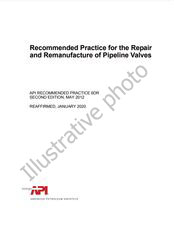We need your consent to use the individual data so that you can see information about your interests, among other things. Click "OK" to give your consent.

API PUBL 4678-ed.1999
Fugitive Emissions from Refinery Process Drains Volume II; Fundamentals of Fugitive Emissions from Refinery Process Drains
Translate name
STANDARD published on 1.4.1999
The information about the standard:
Designation standards: API PUBL 4678-ed.1999
Publication date standards: 1.4.1999
SKU: NS-1139841
The number of pages: 97
Approximate weight : 322 g (0.71 lbs)
Country: American technical standard
Category: Technical standards API
Annotation of standard text API PUBL 4678-ed.1999 :
API PUBL 4678, 1999 Edition, April 1999 - Fugitive Emissions from Refinery Process Drains Volume II; Fundamentals of Fugitive Emissions from Refinery Process Drains
It was originally intended that a three-zone emissions model be developed with the ability to estimate VOC emissions from a falling film, water seal, and channel located below a drain. It was impossible to separate (experimentally) the effects of a falling film from volatilization in an underlying channel or water seal. As such, the effects of a falling film were "lumped" into mass transfer in an underlying channel or water seal.
Five volatile tracers were used in determining mass transfer parameters for the two-zone model. These tracers spanned a wide range of Henrys law constants, i.e., 0.0015 m3liq/m3gas to 7.3 m3liq/m3gas at 25 °C.
A total of 76 experiments were completed with the use of two separate experimental systems. Twelve of these experiments were completed to study gas-liquid mass transfer in the channel below a process drain. Forty experiments were completed to determine rates of air entrainment in a water seal. Seventeen experiments were completed to study the degree of chemical equilibrium between entrained air bubbles and surrounding liquid in a water seal. Seven experiments were completed to study volatilization across the upstream surface of a water seal. Four additional experiments were completed to ascertain volatilization from a falling film, but were inconclusive and not reported herein. No experiments were completed to determine emissions from a water seal below an inactive drain. No experiments were completed to assess gas-liquid mass transfer in the channel below inactive drains.
Several variables can affect mass transfer in a process drain. The primary variables that were studied included process flowrate, hydrodynamic regime (disintegrated or intact liquid flow), and Henrys law constant. The effects of molecular-diffusion coefficients were accounted for in some correlations. The effects of temperature were accounted for through variations in liquid molecular diffusion coefficients, water viscosity and, most importantly, Henrys law constant.
We recommend:
Technical standards updating
Do you want to make sure you use only the valid technical standards?
We can offer you a solution which will provide you a monthly overview concerning the updating of standards which you use.
Would you like to know more? Look at this page.



 Cookies
Cookies
